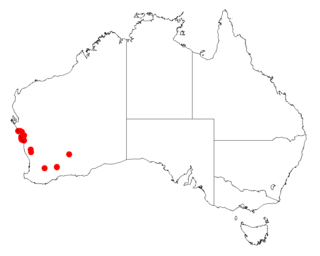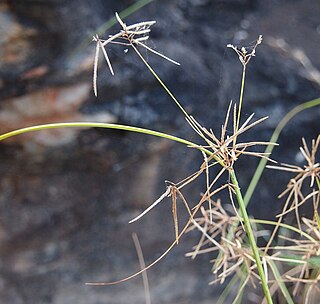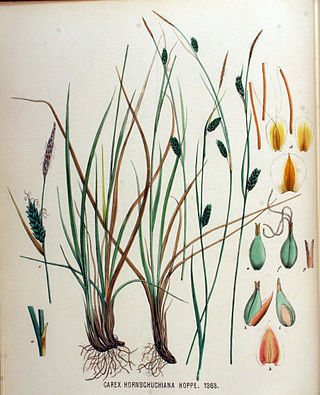
Fimbristylis miliacea, the grasslike fimbry or hoorahgrass, is a species of fimbry that probably originated in coastal tropical Asia but has since spread to most continents as an introduced species. It is a widespread weed in some areas and is sometimes problematic in rice paddies.

Fimbristylis dichotoma, commonly known as forked fimbry or eight day grass, is a sedge of the family Cyperaceae that is native to tropical areas.

Acacia hastulata is a shrub belonging to the genus Acacia and the subgenus Phyllodineae that is endemic to an area in south western Australia.

Acacia oxyclada is a shrub belonging to the genus Acacia and the subgenus Phyllodineae that is endemic to western Australia.
Actinoschoenus arthrostyloides, commonly known as hairy actinoschoenus, is flowering plant in the sedge family, Cyperaceae, that is native to Western Australia throughout parts of the Kimberley region.

Carex pumila, commonly known as strand sedge or spreading sedge, is a species of sedge of the family Cyperaceae.
Cyperus alopecuroides, commonly known as the foxtail flatsedge, is a sedge of the family Cyperaceae that is native to parts of Africa, Asia and Australia.

Cyperus compressus, commonly known as annual sedge, is a sedge of the family Cyperaceae that has a wide distribution throughout countries with warmer climates. It is found in tropical areas of Africa, Asia and the Americas.
Cyperus cuspidatus, commonly known as the coastal plain flatsedge, is a sedge of the family Cyperaceae that is native to seasonally dry tropical areas of Africa, Asia, the Americas and Australia.

Cyperus dactylotes is a sedge of the family Cyperaceae that is native to all of mainland Australia except for Victoria.
Cyperus digitatus, also known as finger flatsedge in the United States, and chang xiao sui suo cao in China, is a sedge of the family Cyperaceae that is native to tropical and subtropical areas of Africa, Asia, the Americas and Australia.

Cyperus gilesii, commonly known as Giles' flat-sedge, is a sedge of the Cyperaceae that is native to Australia.
Cyperus hamulosus is a sedge of the family Cyperaceae. It is native from Bulgaria east to Mongolia, and from Morocco in north Africa down to Namibia in the south. It has also been introduced to western parts of Australia.

Cyperus pygmaeus, also known as dwarf flat sedge, is a sedge of the family Cyperaceae that is native to Australia.
Cyperus rigidellus is a sedge of the family Cyperaceae that is native to Australia.
Cyperus victoriensis, also known as channel nut grass is a sedge of the family Cyperaceae that is native to all the states and territories of mainland Australia.
Eleocharis confervoides is a species of plant in the sedge family (Cyperaceae). It is a perennial, submerged, aquatic and deeply rooted herb. It is known by its common name Algal bulrush and has lots of synonyms. The species has worldwide but very spotty distribution and is native in many tropical and subtropical regions in America, Asia and Africa. It inhabits in water, usually in shallow or deep lakes and ponds. The plant has slender stem with many branches, the leaves float in the water and flowers are usually emergent over the water surface. Fruiting occurs in fall. The most occurrences of plant appear in April and frequency of occurrences is increasing the last years

Fimbristylis velata is a species of sedge native to the North Island of New Zealand and Australia, where it is found in Western Australia, New South Wales, the Northern Territory, Queensland, Victoria, and South Australia.

Carex hostiana, the tawny sedge, is a species of flowering plant in the genus Carex, native to Europe and northeast Canada, and extinct in Massachusetts. It is a member of the Carex flava species complex.
Carex alsophila, commonly known as forest sedge, is a tussock-forming species of perennial sedge in the family Cyperaceae. It is native to Victoria in south eastern Australia.











